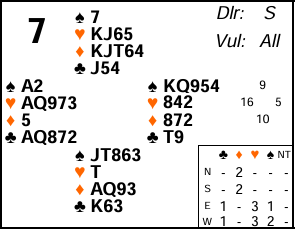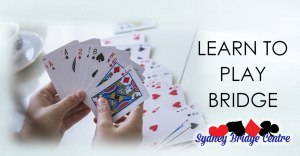City and Canada Bay – Thursday Morning 3rd April 2025.

Board 7 last week saw most East West pairs playing in 4♥. With the foul trump break, this contract had no chance and some ended up as many as 5 off!
Could East West have avoided 4♥? Or could they limit the damage? Possibly – let’s have a look.
In the auction some Souths might choose to open but vulnerable with 10 points and a spade suit he doesn’t particularly want partner to lead, it’s probably better to pass. West will open 1♥, East will most likely raise to 2♥ (some might prefer 1♠ but, having done that, it may be hard to persuade partner you have primary heart support later in the auction – it tends to be better to support immediately). Then it’s really up to West. I suspect many just bid 4♥ straight away. There’s certainly a good case for that – after all give partner ♥K and ♣K and you could easily have 11 very easy tricks (1 spade, 5 hearts and 5 clubs). But this might be a hand where the difference in scoring between imps and matchpoints is significant. At imps, you have more to gain by bidding and making game so you probably just blast it and hope (at imps, especially when vulnerable, the gain for bidding and making game is more than the loss for bidding game and going off – see advanced section for some more explanation of this). At matchpoints it’s very different – you don’t gain more by bidding a pushy game. In practice that translates to bidding more conservatively at pairs. So here, rather then just blasting game, you might just try a “trial bid” – i.e. ask partner for some help in judging whether to bid game or not.
A trial bid most commonly occurs after 1M – 2M. It is fundamentally an invite to partner whether to bid game or not. But asking him to also look at his holding in the trial suit. If West chooses to make a trial here then 3♣ is the obvious choice. Most players play what are known as “long suit trials” – i.e. you have length in the suit and you want partner to look favourably on cards in that suit in judging whether to bid game or not. (There are other forms of trial bids as well though – see advanced section for more details).
Primarily a trial bid is an invitation so if you are maximum for your previous bid you should bid game and if you are are minimum you should not. If your hand is somewhere in between that’s when you should use your holding in the trial suit to help make the decision. Here East should definitely be declining an invite – he has a minimum 5 points (his raise to 2♥ was typically about 5-9), his trumps are poor, he has no shortage, and he has no values in the suit partner has made a trial bid in. Having asked the question, West should then respect his partner’s decision and pass 3♥.
On this hand, given the revolting trump position, the pairs that avoided 4♥ scored very well!
How might the play go in 4♥? Many Norths led their singleton ♠7. Personally I wouldn’t have done this – I would have led a diamond. Holding trump length it’s often right to lead a long suit in the hope of being able to force declarer to trump – that might reduce his trump length so that you end up with more trumps than him (known as having “trump control”) – that can cause havoc for declarer. After two rounds of diamonds, declarer is already in some trouble here. If he crosses to a spade to play on clubs, he can set those up but as soon as he loses to the ♥K, North can play another diamond forcing declarer to ruff again. Now North has more trumps than declarer and must score at least his long one. He might even be in a position to draw trumps and then cash more of his long diamonds.
On the spade lead I imagine many players ran it to their hand to keep the spade suit unblocked. The problem with that is you are now in the wrong hand! You ultimately want to take finesses in both trumps and in clubs – but both require you to be in dummy to do so! If you try to cross to dummy in spades at trick 2 it’s too late as North can ruff. Then the defence can play diamonds and declarer never gets to dummy at all so he will have to lead clubs away from his own hand and it will all get very ugly!
Here declarer needs to win the ♠K in dummy immediately (yes even though that blocks the spade suit). Then he needs to take the club finesse BEFORE the heart finesse even though hearts are trumps. Can you see why? See advanced section for the answer.
If you do start with clubs the play proceeds quite nicely, the ♣Q wins, you cash ♣A and ruff a club in dummy. That sets up your club suit. Now even when things go wrong for you in hearts, it means you have club winners to play. Your losses are limited to 3 trumps and a diamond. Given almost every pair was in 4♥, getting out for only 1 off would actually still have scored quite well – most other declarers went at least 2 off.
Key points to note
A good maxim for bidding is “overbid at teams, underbid at pairs” (this stems from the differences in how the scoring works for each).
A trial bid arises after a raise from 1M to 2M and is typically an invite asking partner to evaluate their holding in the trial suit if they are not clearly min or max for their 2M bid.
With two suited hands where one is trumps it is very often right to play on the side suit first to try and establish it.
If you are in dummy but are short of entries and need to take 2 finesses, consider if taking one first will give you the chance to return to dummy later to then take the other. If so, that’s the one to do first.
As a defender if you have trump length, consider leading a long suit to try and force declarer – that way you may gain trump control. That can be more effective than leading a shortage to try and take ruffs.
More advanced
The scoring between imps and matchpoints is often hard for less experienced players to follow. It can basically be summed up by at imps the AMOUNT of the score difference matters; at matchpoints all that matters is HOW many other pairs you beat – it doesn’t matter if you beat them by 10 points or 1,000 points.
For example start with imps. Suppose in a team game you bid and make game (say 4♥) when vulnerable. You score +620. If your opponents don’t bid it they score +170 and you gain 450 points which is 10 imps. Now suppose you bid game but only make 9 tricks. You score -100. If your opponents don’t bid it they score +140 and you lose -240 points which is 6 imps. Note the lack of symmetry here – if 10 tricks are available you gain 10 imps, if 9 tricks are available you only lose 6 imps. You obviously don’t know in advance how many tricks you will make – but you do know you have more to gain if you go for 10 tricks and are right than you have to lose if you are wrong. That means it’s worth going for 10 tricks more often. In fact the maths actually works out that it is worth attempting a vulnerable game at imps if you have only a 37.5% chance of making it! (Non-vulnerable the score difference isn’t as large but it’s still worth attempting it with a 50% chance of making it).
Now switch to matchpoints. If only two pairs were playing then in the first case you’d score a top and your opponents would score a bottom. In the second case it would be the other way around. But the point is this time the position IS symmetrical – you gain or lose the same amount if you are right or wrong. You don’t have more to gain by gambling to make 10 tricks. That means it’s not worth it at pairs to push to bid dubious games in the hope they make.
Another relevant point is the play. Suppose you think you play the cards better than your opponents. Maybe you will make 10 tricks but they will only make 9? In that case at imps if you bid game and score +620 and they score +140 you gain 10 imps. If you don’t bid game you score +170 and they score +140 so you gain 1 imp. Hence there’s even more to gain by bidding the game.
Now again switch to matchpoints. This time in both the above scenarios you score a top and they score a bottom. Both +620 and +170 beat their +140 and that’s all that matters. It doesn’t matter by how much you beat their +140. So if you play the cards better you don’t need to bid the game to score well. By contrast, suppose that you actually did only make 9 tricks. In the first case you’d now score -100 and in the second case you’d also score +140. That means a bottom and a draw. In that case you actually have more to LOSE by bidding the game!
The upshot of all this is that it pays to be aggressive when bidding game at imps – but it doesn’t pay to do that at matchpoints. Hence the maxim “underbid at pairs, overbid at teams”!
There are basically 3 kinds of trial bids available – long suit, short suit and “help suit”. Long suit were described earlier. Short suit says you have shortage in the suit so this time you want partner to downgrade honours he holds in that suit. Help suit trials are closer to long suit in that you are saying you want help in the suit – but you don’t necessarily have a long suit. Kxx would be a good example – you want some fitting honours. As usual it doesn’t greatly matter which method you use – but it’s vital you and your partner both know! There are some other more complex bidding schemes available that incorporate the ability to bid both long AND short suit trials. These usually involve opener’s immediate bids over 2M being artificial, one saying they have a short suit trial and another saying they have a long suit trial (but the suit isn’t yet specified). Responder relays with the next bid up and opener then reveals which suit they have the relevant trial in. That in theory gives pairs the best of both worlds – in reality a more complex method like that is easier to forget, if the opponents intervene you may not be able to complete the description of your hand, and it may give more information away to the opponents. So it’s not always a good idea!
In the play to 4♥ I said declarer should take the club finesse first. Why? Because of entries. You only have one obvious entry to dummy (♠K) yet you want to take both finesses. If you start with the club finesse then, even if it loses, you will at least have a chance to trump a club to dummy later in order to take the heart finesse (a chance which works on this hand when clubs are 3-3). The same is not true the other way around. If you start with the heart finesse then, even if it wins, you will always have to lead clubs away from your own hand as you won’t ever be able to get back to dummy. Another reason is that it’s generally a good idea to try and set up a side suit as soon as you can when playing in a trump contract. Sometimes doing so takes precedence over drawing trumps (here because you want to ruff at least one club in dummy to help establish the suit).
Julian Foster (many times NSW representative) ♣♦♥♠



